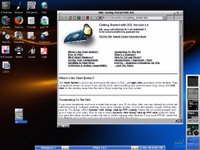 Today marked my introduction to Damn Small Linux (DSL). On the whole, I'm impressed and pleased. It was certainly an ordeal to get it installed, but that was no fault of the distro.
Today marked my introduction to Damn Small Linux (DSL). On the whole, I'm impressed and pleased. It was certainly an ordeal to get it installed, but that was no fault of the distro.Okay, it took me several months to get around to writing this entry, but here it is.
I was installing DSL on a Compaq Presario 9548, circa 1995. It's one of those annoying designs that doesn't have a true BIOS, only a small partition at the beginning of the hard drive that facilitates minor configuration changes. To make matters worse, the CD-ROM isn't included in the boot sequence. I guess in '95 no one at Compaq imagined bootable CDs would someday exist. Luckily DSL offers a bootable floppy disk image. Search their web site and you'll find it soon enough.
I began by formatting a 1.44-MB floppy disk and writing the image to it. For the latter, I used WinImage, but you could probably do just as well with a command line tool like fdimage or rawrite. Both are available from the kind folks at the FreeBSD Project.
With the boot floppy I was able to start the CD installation process without problems. I entered the following commands at the prompt.
dsl 2
cfdisk
The first command boots DSL into runlevel 2, which is essentially text-only mode. The second starts the cfdisk partitioning utility provided with DSL. You should note the path to each partition (e.g. /dev/hda1) so you can assign to them the correct file systems. I've read that 128 or 256 MB is the accepted size for a swap partition these days. The standard installation of DSL doesn't exceed 50 MB in size, so 80 MB seemed reasonable for the bootable ext2 partition. I allocated the rest of the free space to the partition that would contain my home, etc and opt directories.
The partitions also needed to be formatted.
mke2fs /dev/hda1
mke2fs /dev/hda3
mkswap /dev/hda2
swapon /dev/hda2
Then I rebooted to make sure the partitioning and formatting held. After that, it was just a matter of running the installer.
cd /usr/sbin
./frugal_install.sh
You can enter
home=hda3 etc=hda3 opt=hda3
when prompted for additional installation options to put those directories on a separate partition, as I did.
Everything from there proved to be a straightforward Linux installation. But I must say that a 100-MHz Pentium processor and 48 MB of RAM just aren't cutting it, even for such a lightweight distro. I suppose I could always use the box as a mail server or a hardware firewall. Both seem rather unnecessary for my computing needs, though. I imagine I'll find something to do with the old beast eventually.
1 comment:
I just purchased an old Compaq Presario 9548 to experiment with linux. I was wondering where you found information about the bios/hdd setup and if you could point me in a direction to learn more about modifying it. elmer_crap@hotmail.com
Post a Comment